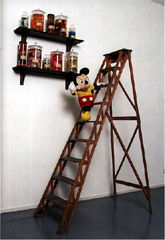


The diorama speaks of many things, but what I see most clearly is an expression of fear.
Through it's glass eyes I see the final moments of the life of this animal: the flash of the hunter's gun and then the momentary reflex as the bullet enters the skull and begins to rip the brain apart. I imagine the guts of this dead animal discarded, and its hollow carcass transported some 12,000 kilometres from its home, only to be filled with paper-pulp, wire and polystyrene then placed in a nostalgic, surreal, vista made of paint and papier maché leaves.
To lie there, day after day, frozen in time for the next 20 years in a fluorescent half-light.
In recent times, museums have begun to change in response to both these criticisms, and more importantly the changing demographic of their public. Children are to some extent, the principle focus of the public science museum, which in some curator's minds means that the same stories can be retold by "dumbing down" the content. What has also become popular is the "blockbuster" show, borrowed from Art museums, where science is viewed as a movie spectacular or theme-park style of daydream experience, with presentation, delivery, and marketing methodologies directly borrowed from the museums modern-day competitors — Hollywood and Disneyland.

Interestingly, most of these new exhibits are temporary, exploring new ways to "work the collection". This is in addition to the spiralling costs of such exhibitions, which, like a travelling sideshow, move from museum to museum, oblivious to geography, but courteous to the dollar. Understandably the modern day exhibit, particularly in recent times, makes extensive use of new technologies. While the concepts for displays have improved, because many exhibitions have borrowed from Hollywood, the results are particularly uninspiring. This is because the museum experience gains when it is different from cinema, or computer games. If the museum competes against these things is will almost always loose.
What is also of interest is how quickly the sophisticated technology becomes outdated, or wears out from the thousands of little fingers constantly banging on those buttons without even waiting around for the results.
